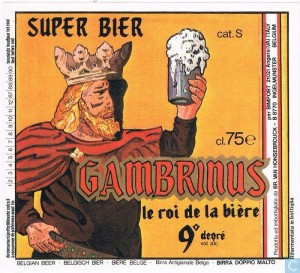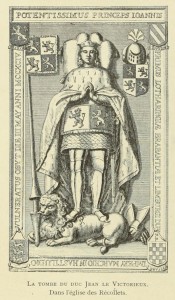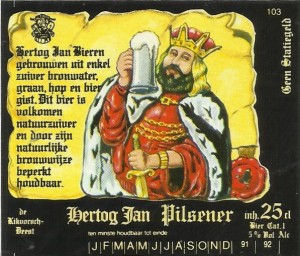Was John of Brabant a beer god? (2)
 Yesterday I met Belgian beer writer Luc de Raedemaeker, who proudly showed me his new ‘Belgian Beer book’, an enormous book with lots of nice photographs. I congratulated him on this remarkable effort, then I opened it and the first thing I read was: ‘Duke John of Brabant, also called Jan Primus…’ Noooo! Are people still repeating this nonsense? So for the last time, after I already told my Dutch-speaking readers: why John of Brabant wasn’t a beer god.
Yesterday I met Belgian beer writer Luc de Raedemaeker, who proudly showed me his new ‘Belgian Beer book’, an enormous book with lots of nice photographs. I congratulated him on this remarkable effort, then I opened it and the first thing I read was: ‘Duke John of Brabant, also called Jan Primus…’ Noooo! Are people still repeating this nonsense? So for the last time, after I already told my Dutch-speaking readers: why John of Brabant wasn’t a beer god.
In the previous article we saw how mythical beer king Gambrinus, initially called Gambrivius, was made up in the first half of the sixteenth century by an imaginative Italian monk, a few zealous German scholars and a bunch of creative poets.[1] One element was however still missing from the legend: duke John I of Brabant, who is always identified as being the same person. So he wasn’t Gambrinus after all? We’ll have a look at that today.
Once Gambrinus had been invented, he developed into a kind of Santa Claus of beer drinking for the German-speaking world. No-one believed he ever really existed, but everyone played along. After all, it was an irresistible idea that there had once been a mythical monarch who invented beer, sitting on his barrel with his crown and ermine mantle, waving around his jug of generously foaming beer. And just like with Santa Claus, everyone was free to invent additional details. At the end of the seventeenth century a writer saw him as the mythical founder of Hamburg, or according to another story he was from Eimbeck, home of bock beer.[2] But no-one claimed that he was the same person as duke John I of Brabant, who lived from around 1253 to 1294.
It may come as no surprise that the first connection was made by a Belgian. Victor Coremans had been active as a writer and philosopher in the German-speaking world for a few decades, when in 1842 he published an article ‘concerning the tradition of Gambrivius, mythical king of Flanders and Brabant’.[3] Coremans mentioned Gambrinus traditions in the towns of Jena, where students would choose a beer king every year, and Stendal, where an old Gambrinus portrait hung in the town brewery.[4] Also, he described what Gambrinus looked like: ‘a Flemish knight from the Middle Ages, decorated with royal or ducal insignia, in his hand a mug of foaming beer.’ And he added: ‘His appearance is similar to portraits of duke John I of Brabant, except that his cheeks are firmer than those usually given to the duke, and the figure adorning his grave in Brussels seems to have served as a model.’[5]
Unaware of the actual background of the Gambrinus figure (the one we saw in the previous article), Coremans looked for an explanation. He quoted a certain De Münster, who was canon (a type of cleric) in the town of Kissingen. De Münster told him that the German brewers’ guilds were modelled on those of today’s Belgium, and that the Gambrinus tradition had come from there. Moreover, De Münster saw ‘a remarkable resemblance of the features of a duke of Brabant who favoured many brewers, and those of the fabled Gambrinus’. Yes: ‘a’ duke. Which duke that was, and where he got this information from in the first place, De Münster doesn’t say. Coremans had some trouble resolving the matter: ‘We couldn’t find any privileges accorded to the brewers by John I; we can find them for John II’. He adds: ‘In earlier times there were, and in Belgium there still are, a great lot of brewery and pub signs that say: at the duke John of Brabant (‘Au duc Jean de Brabant’).’[6]
 And that’s all. In fact, Coremans was doing no more than fanciful guesswork, looking for the origins of that strange German beer god who supposedly was king of Flanders and Brabant. After all, he was unaware of the true background (that we saw in the previous article). The meagre ‘evidence’ for his theory was duke John I’s gravestone, supposedly to be seen in Brussels. But immediately things get fishy: duke John was buried in the Franciscan church in Brussels, that was demolished, along with all its grave monuments, in 1796. So how could Coremans have seen it? However, a drawing of the grave monument has been preserved. On it we see a pious knight, his hands folded, his eyes closed, standing on a lion, lance and metal gloves at his feet. It may look like a lot of things, but it sure doesn’t resemble a generous beer king.[7]
And that’s all. In fact, Coremans was doing no more than fanciful guesswork, looking for the origins of that strange German beer god who supposedly was king of Flanders and Brabant. After all, he was unaware of the true background (that we saw in the previous article). The meagre ‘evidence’ for his theory was duke John I’s gravestone, supposedly to be seen in Brussels. But immediately things get fishy: duke John was buried in the Franciscan church in Brussels, that was demolished, along with all its grave monuments, in 1796. So how could Coremans have seen it? However, a drawing of the grave monument has been preserved. On it we see a pious knight, his hands folded, his eyes closed, standing on a lion, lance and metal gloves at his feet. It may look like a lot of things, but it sure doesn’t resemble a generous beer king.[7]
What happened to Coremans’ article thereafter? Nothing, at first. For over a decade his story was overlooked, until one dr. Karl Gautsch reviewed it in 1858 in the Anzeiger für Kunde der Deutschen Vorzeit, a magazine published by the Germanisches Museum in Nuremberg. Not completely undeservedly he dismissed Coremans’ article as ‘uncertain speculations’ and expressed the hope that someone might shed some more light on the provenance of the Gambrinus character.[8]
And people could have left it at that, if not three months later a dr. Martin Runkel of Düsseldorf replied, in passing adding the last missing piece of Duke John myth to the Gambrinus figure. According to his theory, ‘Gambrinus is a Flemish-German distortion from Jan Primus, John the First of Brabant!’[9]
It is worth the trouble of considering this more closely. In 1858, in the age of steam engines and gas lighting, long after the Middle Ages and the Renaissance, an otherwise completely unknown nobody made a wild guess that the name Gambrinus had come from the self-invented phrase ‘Jan Primus’. However, not only have we seen that Gambrinus was initially called Gambrivius (as Hans Guldenmundt’s print from 1543 shows), it seems quite odd that ordinary folk would combine a Dutch version of the first name (Jan) with a Latin ordinal number (Primus) and would then go and distort it. The Medieval man in the street would be speaking of ‘Jan de Eerste’ (John the First), and scholars in their scriptorium would write ‘Ioannis Primus’, just like on the duke’s gravestone.
Nevertheless, the ‘Gambrinus is Duke John’ theory became popular. In the meantime, the Gambrinus character made its first appearance in the Netherlands, on the wings of the increasingly popular Bavarian beer. In June 1856 the students of Leiden university organised a very real Cambrinus fest, for this ‘Discoverer of beer’. To them, this Cambrinus was however a ‘Bavarian Monarch’ and ‘King of Braband’, but they didn’t see him as Duke John.[10] In 1857 a Bavarian beer house ‘Zum Gambrinus’ opened its doors in Amsterdam, and in the following years similar venues appeared in Rotterdam and Utrecht. Leiden got a gentlemen’s club of that name.[11] As such, Gambrinus became a widely-known figure, not in the least because of advertising. The Royal Bavarian Beer Brewery in Amsterdam, that started operations in 1868, immediately used Gambrinus’ likeness in its advertising material and labels, and they wouldn’t be the last.[12]
Back to duke John I of Brabant. After Coremans’ somewhat hesitating article in 1842 and the loose ‘Jan Primus’ suggestions by dr. Runkel, someone must have put these jigsaw pieces together, and then have started promoted this ‘Duke John is Gambrinus’ theory. I have still to find out who that was, but by 1877 a newspaper reported that ‘new research’ had shown that Gambrinus really was once called ‘Jan Primus’ and that this referred to duke John I.[13]
The strange thing is, that this thirteenth-century duke John wasn’t such a bad candidate for a beer king. He clearly enjoyed life, and when not successfully fighting battles he wrote love poetry and entertained himself with women, hunting and tournaments. Such a life style suggests alcohol consumption, but there is no evidence that he actually drank anything, let alone beer. After all, a duke could easily afford good wines.
Anyway, it all nicely came together, not just for brewers in both the Belgian and the Dutch part of Brabant, but also for those in the region of Limburg. John had been duke not just of Brabant, but of Limburg as well, which he conquered in 1289. However, this was a completely different area than what we know as Limburg today: it was centred on the town of Limbourg-sur-Vesdre, which now lies in the Belgian province of Liège.
 Over the course of the nineteenth century, the name Gambrinus became completely conflated with that of the duke of Brabant and for most people it is impossible to untangle the web of misunderstandings. The weirdest nonsense and contortions circulate on poor Duke John, and they never stand up to any scrutiny. No, John was never ‘honorary president of the Brussels brewers’ guild’[14], because that was founded in 1365, long after his death. Also, prior to the battle of Worringen (1288) he didn’t say to his soldiers: ‘you will drink like your brave ancestors’, like the Hertog Jan tasting room website claims, or like a song by the Band Zonder Banaan (‘Band Without a Banana’, don’t ask) has mentioned.[15] The original text in the Rhyming Chronicle by eye witness Jan of Heelu doesn’t speak of drinken (‘drinking’) but of dinken (‘thinking’)![16]
Over the course of the nineteenth century, the name Gambrinus became completely conflated with that of the duke of Brabant and for most people it is impossible to untangle the web of misunderstandings. The weirdest nonsense and contortions circulate on poor Duke John, and they never stand up to any scrutiny. No, John was never ‘honorary president of the Brussels brewers’ guild’[14], because that was founded in 1365, long after his death. Also, prior to the battle of Worringen (1288) he didn’t say to his soldiers: ‘you will drink like your brave ancestors’, like the Hertog Jan tasting room website claims, or like a song by the Band Zonder Banaan (‘Band Without a Banana’, don’t ask) has mentioned.[15] The original text in the Rhyming Chronicle by eye witness Jan of Heelu doesn’t speak of drinken (‘drinking’) but of dinken (‘thinking’)![16]
Of course it remains a strong symbol, this jolly beer king-cum-duke. The Dutch towns of Etten, Boxmeer, and Schinveld have known a Cambrinus brewery, and also Oranjeboom and Amstel used it as a brand name. Belgian has its Primus pils by Haacht and countless pubs bear his name, not in the least Jan Primus, the first specialty beer café the Netherlands ever had (as far as I know). And of course there is the Hertog Jan (‘Duke John’) brewery in Arcen, that has used that name since 1981.
But if we then accept that Gambrinus/Gambrivius has never existed and that he was invented by a bunch of Renaissance scholars, and that duke John I of Brabant was a party-goer but that we know nothing of his drinking habits (except some unfounded and relatively modern legends), and that no-one ever called him ‘Jan Primus’ until that dr. Runkel from Düsseldorf invented that name right out of thin air in 1858, then I never want to find these utter fabrications in history books again. Neither in brewery anthologies, history pages on websites and all those other places where we may expect to find serious beer history. And that includes Luc de Raedemaeker’s beautiful new book. Duke John of Brabant enjoyed life, but he wasn’t a beer god and no-one ever called him Jan Primus.[17]
[1] And then there is this Gambrinus portrait that circulates on the internet at a low resolution, featuring a king wearing a crown with barley attached to it, a glass and a wooden jug, accompanied by a poem and the year 1526. Supposedly it is to be found in the ‘Deutsches Brauereimuseum’ in Munich, though currently there is no museum of that name there. It is not mentioned in any of the Gambrinus literature that I found. According to the Bild Spezial Atlas guide to German beer from 1984, it dates from the nineteenth century.
[2] Handwörterbuch des Deutsche Aberglaubens, Band III, Berlin/Leipzig 1930/1931, p. 282; Amalgama, nieuwe oeconomische bibliotheek, second year part one, p. 446, 458, 459.
[3] Victor Coremans, ‘Notes concernant la tradition de Gambrivius, roi mythique de Flandre et de Brabant’, in: Compte-rendu des séances de la commission royale d’histoire ou receuil de ses bulletins, Tome V, Brussels 1842, here p. 378-388.
[4] Coremans, ‘Notes’, p. 380.
[5] Coremans, ‘Notes’, p. 379.
[6] Coremans, ‘Notes’, p. 382-383.
[7] Louis Hymans, Bruxelles à travers les ages, Brussels 1882, p. 428.
[8] Anzeiger für Kunde der Deutschen Vorzeit, Nuremberg 1858, p. 81-82.
[9] Anzeiger, p. 179. In fact, Runkel was a journalist, writing for the Eberfelder Zeitung, mentioned by Friedrich Engels in his Letters from Wuppertal in 1839: https://www.marxists.org/archive/marx/works/1839/03/telegraph.htm.
[10] Algemeen Handelsblad 5-6-1856; Provinciale Drentsche en Asser courant 3-9-1856.
[11] Algemeen Handelsblad 19-11-1857; NRC 4-8-1858; Utrechtsche provinciale en stads-courant 14-04-1859; Leydse courant 18-2-1861.
[12] Catalogus van eenen uitmuntenden en uitgebreiden atlas van topographische en historische prenten, teekeningen en portretten betreffende de stad Amsterdam, Amsterdam 1869, p. 10.
[13] Het nieuws van den dag 22-7-1877.
[14] Twan Dohmen, Van mol tot raaf. Bier in het Rijk van Nijmegen, Nijmegen 2015, p. 13.
[15] http://www.hertogjanproeverij.nl/cafe/wie-hertog-jan; https://www.youtube.com/watch?v=McVcBTZ6We4
[16] Jan van Heelu (red. J.F. Willems), Rymkronyk van Jan van Heelu betreffende den slag van Woeringen van het jaer 1288, Brussel 1836, p. 177. http://www.dbnl.org/tekst/heel001jfwi01_01/heel001jfwi01_01_0012.php.
[17] This article was based on an earlier version in Dutch, http://verlorenbieren.nl/was-hertog-jan-een-biergod-2/.For the history of the Gambrinus character also see: Jan Grauls, ‘De legende van koning Gambrinus’, in: Terug naar de oorsprong, Hasselt 1966; Wolfgang Stammler, Kleine schriften zur Literaturgeschichte des Mittelalters, p. 120-124.






Hallo Roel,
Gambrinus en Cambrinus zijn dezelfde. Waar wordt gesproken over Gambrinus met een G, en over Cambrinus met een C ?
Hallo Leon,
Gambrinus met een G is de oorspronkelijke versie. De versie met een C is later ontstaan. De twee worden nu door elkaar gebruikt.